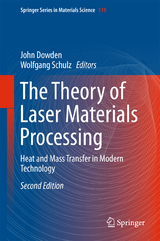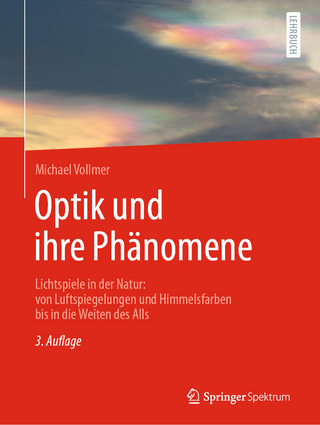
The Theory of Laser Materials Processing
Heat and Mass Transfer in Modern Technology
Seiten
2014
Springer (Verlag)
978-94-007-8959-3 (ISBN)
Springer (Verlag)
978-94-007-8959-3 (ISBN)
- Titel erscheint in neuer Auflage
- Artikel merken
Zu diesem Artikel existiert eine Nachauflage
The purpose of this book is to show how general principles afford insight into laser processes. The principles may be from fundamental physical theory or from direct observation, but understanding of the general characteristics of a process is essential.
Theuseoflasersinmaterialsprocessinghasbecomewidespreadinrecent years,sothatanunderstandingofthenatureofheatandmasstransferin thisbranchofmoderntechnologyisofincreasingimportance. Theaimofthe authorsofthisbookistoconcentrateonthephysicalprocesses;thesecanbe developedfromamathematicalpointofview,orfromdirectexperimental- derivedobservation. Thetwoapproachesarecomplementary;eachcanprovide insightsandthesynthesisofthetwocanleadtoaverypowerfulunderstanding oftheprocessesinvolved. Mathematicalmodellingofphysicalprocesseshas hadanimportantroletoplayinthedevelopmentoftechnologyoverthe centuriesandparticularlysointhelastonehundredand?ftyyearsorso. Itcanbearguedthatitismoreimportanttodaythaneverbeforesincethe availabilityofhigh-speedcomputersallowsaccuratenumericalsimulationof industrialprocessesatafractionofthecostofthecorrespondingexperiments. Thisisoneaspectofmathematicalmodelling,highpro?leandmuchvalued, butitisnottheonlyone. Inthepastmathematicalmodellinghadtorelyonqualitativeinves- gation,veryspecialanalyticalsolutions,orinaccurateandtime-consuming calculationsperformedwithlittleinthewayoftabulatedormechanical assistance.
Logtablesandsliderulesarestillrememberedbypeopleworking today,thoughtherearesurelyfewwhoregrettheirdisappearance. Thevalueanddistinctivefunctionofmethodsbasedontheanalytical approachisnowbecomingmuchclearer,nowthattheyarenolongerexpected toproducedetailedimitationsofwhathappensinrealexperimentsofind- trialprocesses,afunctionnowful?lledmostlybynumericalmethods,c- sideredbelow. Theemphasistodayisontheirabilitytocon?rmandextend ourunderstandingofthebasicphysicalmechanismsinvolvedintheprocesses of interest. These are essential for any intelligent use of numerical simulation. Theargumentaboutthevalueofteachingpeoplehowtodoarithmetic themselveswithouttheaidofacalculatorseemstobepassingintohistory, vi Preface butitisanimportantoneandprovidesasimpleanalogy. Ifsomeonedoes nothaveafeelingfornumbersandthewayarithmeticworks,theywillalltoo easilyfailtospotanerrorproducedbyamachine. Computersarenotinfallible -andneitherarethosewhobuildorprogramthem. Computersarenow takingonlessmundanemathematicaltasksandthesamecontroversiesare appearinginconnectionwithalgebraicmanipulation.
Equally,andwitheven greaterpenaltiesintermsofcostintheeventoferrors,thesameconsiderations applytonumericalsimulationofmajorindustrialprocesses. Awarenessofthe analyticalsolutionscanbeinvaluableindistinguishingtherightfromthe wrong,i. e. forthepractitionertounderstandthebasisofthework,andto haveanideaofthekindsofoutcomesthatareplausible-andtorecognise thosewhicharenot. Thephrase"mathematicalmodelling"is,however,ambiguous,perhaps morenowthanithaseverbeen. Thereisanenormousamountofworkdone todayonsimulationbasedontheuseofverypowerfulcomputerprograms, anditisquitecorrectlyreferredtoasmathematicalmodelling. Theprograms aresometimesconstructedin-housebutareusuallycommercialpackages. This isanentirelyvalidapproachwithspeci?c(generallycommercial)objectives. Ingeneraltherearetwouses. Thedominantobjectiveisnumericalagreement withaparticularexperimentinthe?rstinstance,leadingtopredictivec- mercialuseinthesecondinstance. Thesecondobjectiveistheclari?cation ofphysicalmechanisms,aimedatthegenerationofunderstandingofcomplex interconnectedprocesses,ratherthantheexactreproductionofaparticular experiment. Itissometimesoverlookedthat,withsu?cientcare,anum- icalapproachisequallyvalidintheinvestigationofphysicalfundamentals.
Numericalsimulationisnotacentraltopicofthisbook,butbecauseofits crucialimportancetoeachofthetwousestowhichnumericalmodellingcan beput,itisvitalthatthecomputationalbasisoftheworkshouldbec- pletelysound. Inaddition,thelevelofprocessdetailwhichcanbeconsidered bythenumericalapproachusuallyexceedswhatispossiblewiththeanaly- calapproachsigni?cantly,leavinglittlechoicebuttoreverttothenumerical treatmentwheninvestigatingtheinterconnectionsbetweenprocesses. Itis forthesereasonsthatthebookconcludeswithachapteroncomprehensive numericalsimulation. Inmanyways,theapproachadoptedhereiscomplementarytothemore phenomenologicalapproach. Itisalwaysimportantina?eldwhichhasvery directindustrialapplicationstobearinmindhowtechniquessuchasthose describedherewillbeused,butitisessentialnottolosesightofthef- damentals. Thereareserioussafetyimplications;therearecostimplications; therearemoralimplications;thereareconsiderationsoftheappropriateness ofthetechnologytotheapplicationunderconsideration. Aproperrespectfor alltheserequiresanunderstandingofthefundamentals. Wearealltoowellawarethatthisbookdoeslittlemorethanscratch thesurfaceoftheproblemsinvolvedinafundamentalunderstandingofthese phenomena.
Ifwehaveprovidedideasandinformationthatcauseothersto Preface vii testthemexperimentallyorintellectually,agreewiththemordisputethem vigorously,anddevelopthemfurther,wewillconsiderthatwehaveachieved ouraim. Colchester April,2008 JohnDowden Contents 1MathematicsinLaserProcessing JohnDowden...1 1. 1 MathematicsanditsApplication...1 1. 2 FormulationinTermsofPartialDi?erentialEquations...3 1. 2. 1 LengthScales...3 1. 2. 2 ConservationEquationsandtheirGeneralisations...4 1. 2. 3 GoverningEquationsofGeneralised ConservationType...7 1. 2. 4 Gauss'is,however,ambiguous,perhaps morenowthanithaseverbeen. Thereisanenormousamountofworkdone todayonsimulationbasedontheuseofverypowerfulcomputerprograms, anditisquitecorrectlyreferredtoasmathematicalmodelling. Theprograms aresometimesconstructedin-housebutareusuallycommercialpackages. This isanentirelyvalidapproachwithspeci?c(generallycommercial)objectives. Ingeneraltherearetwouses. Thedominantobjectiveisnumericalagreement withaparticularexperimentinthe?rstinstance,leadingtopredictivec- mercialuseinthesecondinstance. Thesecondobjectiveistheclari?cation ofphysicalmechanisms,aimedatthegenerationofunderstandingofcomplex interconnectedprocesses,ratherthantheexactreproductionofaparticular experiment.
Itissometimesoverlookedthat,withsu?cientcare,anum- icalapproachisequallyvalidintheinvestigationofphysicalfundamentals. Numericalsimulationisnotacentraltopicofthisbook,butbecauseofits crucialimportancetoeachofthetwousestowhichnumericalmodellingcan beput,itisvitalthatthecomputationalbasisoftheworkshouldbec- pletelysound. Inaddition,thelevelofprocessdetailwhichcanbeconsidered bythenumericalapproachusuallyexceedswhatispossiblewiththeanaly- calapproachsigni?cantly,leavinglittlechoicebuttoreverttothenumerical treatmentwheninvestigatingtheinterconnectionsbetweenprocesses. Itis forthesereasonsthatthebookconcludeswithachapteroncomprehensive numericalsimulation. Inmanyways,theapproachadoptedhereiscomplementarytothemore phenomenologicalapproach. Itisalwaysimportantina?eldwhichhasvery directindustrialapplicationstobearinmindhowtechniquessuchasthose describedherewillbeused,butitisessentialnottolosesightofthef- damentals. Thereareserioussafetyimplications;therearecostimplications; therearemoralimplications;thereareconsiderationsoftheappropriateness ofthetechnologytotheapplicationunderconsideration. Aproperrespectfor alltheserequiresanunderstandingofthefundamentals.
Wearealltoowellawarethatthisbookdoeslittlemorethanscratch thesurfaceoftheproblemsinvolvedinafundamentalunderstandingofthese phenomena. Ifwehaveprovidedideasandinformationthatcauseothersto Preface vii testthemexperimentallyorintellectually,agreewiththemordisputethem vigorously,anddevelopthemfurther,wewillconsiderthatwehaveachieved ouraim. Colchester April,2008 JohnDowden Contents 1MathematicsinLaserProcessing JohnDowden...1 1. 1 MathematicsanditsApplication...1 1. 2 FormulationinTermsofPartialDi?erentialEquations...3 1. 2. 1 LengthScales...3 1. 2. 2 ConservationEquationsandtheirGeneralisations...4 1. 2. 3 GoverningEquationsofGeneralised ConservationType...7 1. 2. 4 Gauss'Theuseoflasersinmaterialsprocessinghasbecomewidespreadinrecent years,sothatanunderstandingofthenatureofheatandmasstransferin thisbranchofmoderntechnologyisofincreasingimportance. Theaimofthe authorsofthisbookistoconcentrateonthephysicalprocesses;thesecanbe developedfromamathematicalpointofview,orfromdirectexperimental- derivedobservation. Thetwoapproachesarecomplementary;eachcanprovide insightsandthesynthesisofthetwocanleadtoaverypowerfulunderstanding oftheprocessesinvolved.
Mathematicalmodellingofphysicalprocesseshas hadanimportantroletoplayinthedevelopmentoftechnologyoverthe centuriesandparticularlysointhelastonehundredand?ftyyearsorso. Itcanbearguedthatitismoreimportanttodaythaneverbeforesincethe availabilityofhigh-speedcomputersallowsaccuratenumericalsimulationof industrialprocessesatafractionofthecostofthecorrespondingexperiments. Thisisoneaspectofmathematicalmodelling,highpro?leandmuchvalued, butitisnottheonlyone. Inthepastmathematicalmodellinghadtorelyonqualitativeinves- gation,veryspecialanalyticalsolutions,orinaccurateandtime-consuming calculationsperformedwithlittleinthewayoftabulatedormechanical assistance. Logtablesandsliderulesarestillrememberedbypeopleworking today,thoughtherearesurelyfewwhoregrettheirdisappearance. Thevalueanddistinctivefunctionofmethodsbasedontheanalytical approachisnowbecomingmuchclearer,nowthattheyarenolongerexpected toproducedetailedimitationsofwhathappensinrealexperimentsofind- trialprocesses,afunctionnowful?lledmostlybynumericalmethods,c- sideredbelow. Theemphasistodayisontheirabilitytocon?rmandextend ourunderstandingofthebasicphysicalmechanismsinvolvedintheprocesses of interest.
These are essential for any intelligent use of numerical simulation. Theargumentaboutthevalueofteachingpeoplehowtodoarithmetic themselveswithouttheaidofacalculatorseemstobepassingintohistory, vi Preface butitisanimportantoneandprovidesasimpleanalogy. Ifsomeonedoes nothaveafeelingfornumbersandthewayarithmeticworks,theywillalltoo easilyfailtospotanerrorproducedbyamachine. Computersarenotinfallible -andneitherarethosewhobuildorprogramthem. Computersarenow takingonlessmundanemathematicaltasksandthesamecontroversiesare appearinginconnectionwithalgebraicmanipulation. Equally,andwitheven greaterpenaltiesintermsofcostintheeventoferrors,thesameconsiderations applytonumericalsimulationofmajorindustrialprocesses. Awarenessofthe analyticalsolutionscanbeinvaluableindistinguishingtherightfromthe wrong,i. e. forthepractitionertounderstandthebasisofthework,andto haveanideaofthekindsofoutcomesthatareplausible-andtorecognise thosewhicharenot. Thephrase"mathematicalmodelling"is,however,ambiguous,perhaps morenowthanithaseverbeen. Thereisanenormousamountofworkdone todayonsimulationbasedontheuseofverypowerfulcomputerprograms, anditisquitecorrectlyreferredtoasmathematicalmodelling.
Theprograms aresometimesconstructedin-housebutareusuallycommercialpackages. This isanentirelyvalidapproachwithspeci?c(generallycommercial)objectives. Ingeneraltherearetwouses. Thedominantobjectiveisnumericalagreement withaparticularexperimentinthe?rstinstance,leadingtopredictivec- mercialuseinthesecondinstance. Thesecondobjectiveistheclari?cation ofphysicalmechanisms,aimedatthegenerationofunderstandingofcomplex interconnectedprocesses,ratherthantheexactreproductionofaparticular experiment. Itissometimesoverlookedthat,withsu?cientcare,anum- icalapproachisequallyvalidintheinvestigationofphysicalfundamentals. Numericalsimulationisnotacentraltopicofthisbook,butbecauseofits crucialimportancetoeachofthetwousestowhichnumericalmodellingcan beput,itisvitalthatthecomputationalbasisoftheworkshouldbec- pletelysound. Inaddition,thelevelofprocessdetailwhichcanbeconsidered bythenumericalapproachusuallyexceedswhatispossiblewiththeanaly- calapproachsigni?cantly,leavinglittlechoicebuttoreverttothenumerical treatmentwheninvestigatingtheinterconnectionsbetweenprocesses. Itis forthesereasonsthatthebookconcludeswithachapteroncomprehensive numericalsimulation.
Inmanyways,theapproachadoptedhereiscomplementarytothemore phenomenologicalapproach. Itisalwaysimportantina?eldwhichhasvery directindustrialapplicationstobearinmindhowtechniquessuchasthose describedherewillbeused,butitisessentialnottolosesightofthef- damentals. Thereareserioussafetyimplications;therearecostimplications; therearemoralimplications;thereareconsiderationsoftheappropriateness ofthetechnologytotheapplicationunderconsideration. Aproperrespectfor alltheserequiresanunderstandingofthefundamentals. Wearealltoowellawarethatthisbookdoeslittlemorethanscratch thesurfaceoftheproblemsinvolvedinafundamentalunderstandingofthese phenomena. Ifwehaveprovidedideasandinformationthatcauseothersto Preface vii testthemexperimentallyorintellectually,agreewiththemordisputethem vigorously,anddevelopthemfurther,wewillconsiderthatwehaveachieved ouraim. Colchester April,2008 JohnDowden Contents 1MathematicsinLaserProcessing JohnDowden...1 1. 1 MathematicsanditsApplication...1 1. 2 FormulationinTermsofPartialDi?erentialEquations...3 1. 2. 1 LengthScales...3 1. 2. 2 ConservationEquationsandtheirGeneralisations...4 1. 2. 3 GoverningEquationsofGeneralised ConservationType...7 1. 2. 4 Gauss'sLaw...10 1.
3 BoundaryandInterfaceConditions...11 1. 3. 1 GeneralisedConservationConditions...11 1. 3. 2 TheKinematicConditioninFluidDynamics...13 1. 4 Fick'sLaws...15 1. 5 Electromagnetism...15 1. 5. 1 Maxwell'sEquations...15 1. 5. 2 Ohm'sLaw...18 References...19 2SimulationofLaserCutting WolfgangSchulz,MarkusNiessen,UrsEppelt,KerstinKowalick...21 2. 1 Introduction...22 2. 1. 1 PhysicalPhenomenaandExperimentalObservation...23 2. 2 MathematicalFormulationandAnalysis...26 2. 2. 1 TheOne-PhaseProblem...29 2. 2. 2 TheTwo-PhaseProblem...42 2. 2. 3 Three-PhaseProblem...51 2. 3 Outlook...64 2. 4 Acknowledgements...65 References...65 x Contents 3KeyholeWelding:TheSolidandLiquidPhases AlexanderKaplan...71 3. 1 HeatGenerationandHeatTransfer...71 3. 1. 1 Absorption...
Theuseoflasersinmaterialsprocessinghasbecomewidespreadinrecent years,sothatanunderstandingofthenatureofheatandmasstransferin thisbranchofmoderntechnologyisofincreasingimportance. Theaimofthe authorsofthisbookistoconcentrateonthephysicalprocesses;thesecanbe developedfromamathematicalpointofview,orfromdirectexperimental- derivedobservation. Thetwoapproachesarecomplementary;eachcanprovide insightsandthesynthesisofthetwocanleadtoaverypowerfulunderstanding oftheprocessesinvolved. Mathematicalmodellingofphysicalprocesseshas hadanimportantroletoplayinthedevelopmentoftechnologyoverthe centuriesandparticularlysointhelastonehundredand?ftyyearsorso. Itcanbearguedthatitismoreimportanttodaythaneverbeforesincethe availabilityofhigh-speedcomputersallowsaccuratenumericalsimulationof industrialprocessesatafractionofthecostofthecorrespondingexperiments. Thisisoneaspectofmathematicalmodelling,highpro?leandmuchvalued, butitisnottheonlyone. Inthepastmathematicalmodellinghadtorelyonqualitativeinves- gation,veryspecialanalyticalsolutions,orinaccurateandtime-consuming calculationsperformedwithlittleinthewayoftabulatedormechanical assistance.
Logtablesandsliderulesarestillrememberedbypeopleworking today,thoughtherearesurelyfewwhoregrettheirdisappearance. Thevalueanddistinctivefunctionofmethodsbasedontheanalytical approachisnowbecomingmuchclearer,nowthattheyarenolongerexpected toproducedetailedimitationsofwhathappensinrealexperimentsofind- trialprocesses,afunctionnowful?lledmostlybynumericalmethods,c- sideredbelow. Theemphasistodayisontheirabilitytocon?rmandextend ourunderstandingofthebasicphysicalmechanismsinvolvedintheprocesses of interest. These are essential for any intelligent use of numerical simulation. Theargumentaboutthevalueofteachingpeoplehowtodoarithmetic themselveswithouttheaidofacalculatorseemstobepassingintohistory, vi Preface butitisanimportantoneandprovidesasimpleanalogy. Ifsomeonedoes nothaveafeelingfornumbersandthewayarithmeticworks,theywillalltoo easilyfailtospotanerrorproducedbyamachine. Computersarenotinfallible -andneitherarethosewhobuildorprogramthem. Computersarenow takingonlessmundanemathematicaltasksandthesamecontroversiesare appearinginconnectionwithalgebraicmanipulation.
Equally,andwitheven greaterpenaltiesintermsofcostintheeventoferrors,thesameconsiderations applytonumericalsimulationofmajorindustrialprocesses. Awarenessofthe analyticalsolutionscanbeinvaluableindistinguishingtherightfromthe wrong,i. e. forthepractitionertounderstandthebasisofthework,andto haveanideaofthekindsofoutcomesthatareplausible-andtorecognise thosewhicharenot. Thephrase"mathematicalmodelling"is,however,ambiguous,perhaps morenowthanithaseverbeen. Thereisanenormousamountofworkdone todayonsimulationbasedontheuseofverypowerfulcomputerprograms, anditisquitecorrectlyreferredtoasmathematicalmodelling. Theprograms aresometimesconstructedin-housebutareusuallycommercialpackages. This isanentirelyvalidapproachwithspeci?c(generallycommercial)objectives. Ingeneraltherearetwouses. Thedominantobjectiveisnumericalagreement withaparticularexperimentinthe?rstinstance,leadingtopredictivec- mercialuseinthesecondinstance. Thesecondobjectiveistheclari?cation ofphysicalmechanisms,aimedatthegenerationofunderstandingofcomplex interconnectedprocesses,ratherthantheexactreproductionofaparticular experiment. Itissometimesoverlookedthat,withsu?cientcare,anum- icalapproachisequallyvalidintheinvestigationofphysicalfundamentals.
Numericalsimulationisnotacentraltopicofthisbook,butbecauseofits crucialimportancetoeachofthetwousestowhichnumericalmodellingcan beput,itisvitalthatthecomputationalbasisoftheworkshouldbec- pletelysound. Inaddition,thelevelofprocessdetailwhichcanbeconsidered bythenumericalapproachusuallyexceedswhatispossiblewiththeanaly- calapproachsigni?cantly,leavinglittlechoicebuttoreverttothenumerical treatmentwheninvestigatingtheinterconnectionsbetweenprocesses. Itis forthesereasonsthatthebookconcludeswithachapteroncomprehensive numericalsimulation. Inmanyways,theapproachadoptedhereiscomplementarytothemore phenomenologicalapproach. Itisalwaysimportantina?eldwhichhasvery directindustrialapplicationstobearinmindhowtechniquessuchasthose describedherewillbeused,butitisessentialnottolosesightofthef- damentals. Thereareserioussafetyimplications;therearecostimplications; therearemoralimplications;thereareconsiderationsoftheappropriateness ofthetechnologytotheapplicationunderconsideration. Aproperrespectfor alltheserequiresanunderstandingofthefundamentals. Wearealltoowellawarethatthisbookdoeslittlemorethanscratch thesurfaceoftheproblemsinvolvedinafundamentalunderstandingofthese phenomena.
Ifwehaveprovidedideasandinformationthatcauseothersto Preface vii testthemexperimentallyorintellectually,agreewiththemordisputethem vigorously,anddevelopthemfurther,wewillconsiderthatwehaveachieved ouraim. Colchester April,2008 JohnDowden Contents 1MathematicsinLaserProcessing JohnDowden...1 1. 1 MathematicsanditsApplication...1 1. 2 FormulationinTermsofPartialDi?erentialEquations...3 1. 2. 1 LengthScales...3 1. 2. 2 ConservationEquationsandtheirGeneralisations...4 1. 2. 3 GoverningEquationsofGeneralised ConservationType...7 1. 2. 4 Gauss'is,however,ambiguous,perhaps morenowthanithaseverbeen. Thereisanenormousamountofworkdone todayonsimulationbasedontheuseofverypowerfulcomputerprograms, anditisquitecorrectlyreferredtoasmathematicalmodelling. Theprograms aresometimesconstructedin-housebutareusuallycommercialpackages. This isanentirelyvalidapproachwithspeci?c(generallycommercial)objectives. Ingeneraltherearetwouses. Thedominantobjectiveisnumericalagreement withaparticularexperimentinthe?rstinstance,leadingtopredictivec- mercialuseinthesecondinstance. Thesecondobjectiveistheclari?cation ofphysicalmechanisms,aimedatthegenerationofunderstandingofcomplex interconnectedprocesses,ratherthantheexactreproductionofaparticular experiment.
Itissometimesoverlookedthat,withsu?cientcare,anum- icalapproachisequallyvalidintheinvestigationofphysicalfundamentals. Numericalsimulationisnotacentraltopicofthisbook,butbecauseofits crucialimportancetoeachofthetwousestowhichnumericalmodellingcan beput,itisvitalthatthecomputationalbasisoftheworkshouldbec- pletelysound. Inaddition,thelevelofprocessdetailwhichcanbeconsidered bythenumericalapproachusuallyexceedswhatispossiblewiththeanaly- calapproachsigni?cantly,leavinglittlechoicebuttoreverttothenumerical treatmentwheninvestigatingtheinterconnectionsbetweenprocesses. Itis forthesereasonsthatthebookconcludeswithachapteroncomprehensive numericalsimulation. Inmanyways,theapproachadoptedhereiscomplementarytothemore phenomenologicalapproach. Itisalwaysimportantina?eldwhichhasvery directindustrialapplicationstobearinmindhowtechniquessuchasthose describedherewillbeused,butitisessentialnottolosesightofthef- damentals. Thereareserioussafetyimplications;therearecostimplications; therearemoralimplications;thereareconsiderationsoftheappropriateness ofthetechnologytotheapplicationunderconsideration. Aproperrespectfor alltheserequiresanunderstandingofthefundamentals.
Wearealltoowellawarethatthisbookdoeslittlemorethanscratch thesurfaceoftheproblemsinvolvedinafundamentalunderstandingofthese phenomena. Ifwehaveprovidedideasandinformationthatcauseothersto Preface vii testthemexperimentallyorintellectually,agreewiththemordisputethem vigorously,anddevelopthemfurther,wewillconsiderthatwehaveachieved ouraim. Colchester April,2008 JohnDowden Contents 1MathematicsinLaserProcessing JohnDowden...1 1. 1 MathematicsanditsApplication...1 1. 2 FormulationinTermsofPartialDi?erentialEquations...3 1. 2. 1 LengthScales...3 1. 2. 2 ConservationEquationsandtheirGeneralisations...4 1. 2. 3 GoverningEquationsofGeneralised ConservationType...7 1. 2. 4 Gauss'Theuseoflasersinmaterialsprocessinghasbecomewidespreadinrecent years,sothatanunderstandingofthenatureofheatandmasstransferin thisbranchofmoderntechnologyisofincreasingimportance. Theaimofthe authorsofthisbookistoconcentrateonthephysicalprocesses;thesecanbe developedfromamathematicalpointofview,orfromdirectexperimental- derivedobservation. Thetwoapproachesarecomplementary;eachcanprovide insightsandthesynthesisofthetwocanleadtoaverypowerfulunderstanding oftheprocessesinvolved.
Mathematicalmodellingofphysicalprocesseshas hadanimportantroletoplayinthedevelopmentoftechnologyoverthe centuriesandparticularlysointhelastonehundredand?ftyyearsorso. Itcanbearguedthatitismoreimportanttodaythaneverbeforesincethe availabilityofhigh-speedcomputersallowsaccuratenumericalsimulationof industrialprocessesatafractionofthecostofthecorrespondingexperiments. Thisisoneaspectofmathematicalmodelling,highpro?leandmuchvalued, butitisnottheonlyone. Inthepastmathematicalmodellinghadtorelyonqualitativeinves- gation,veryspecialanalyticalsolutions,orinaccurateandtime-consuming calculationsperformedwithlittleinthewayoftabulatedormechanical assistance. Logtablesandsliderulesarestillrememberedbypeopleworking today,thoughtherearesurelyfewwhoregrettheirdisappearance. Thevalueanddistinctivefunctionofmethodsbasedontheanalytical approachisnowbecomingmuchclearer,nowthattheyarenolongerexpected toproducedetailedimitationsofwhathappensinrealexperimentsofind- trialprocesses,afunctionnowful?lledmostlybynumericalmethods,c- sideredbelow. Theemphasistodayisontheirabilitytocon?rmandextend ourunderstandingofthebasicphysicalmechanismsinvolvedintheprocesses of interest.
These are essential for any intelligent use of numerical simulation. Theargumentaboutthevalueofteachingpeoplehowtodoarithmetic themselveswithouttheaidofacalculatorseemstobepassingintohistory, vi Preface butitisanimportantoneandprovidesasimpleanalogy. Ifsomeonedoes nothaveafeelingfornumbersandthewayarithmeticworks,theywillalltoo easilyfailtospotanerrorproducedbyamachine. Computersarenotinfallible -andneitherarethosewhobuildorprogramthem. Computersarenow takingonlessmundanemathematicaltasksandthesamecontroversiesare appearinginconnectionwithalgebraicmanipulation. Equally,andwitheven greaterpenaltiesintermsofcostintheeventoferrors,thesameconsiderations applytonumericalsimulationofmajorindustrialprocesses. Awarenessofthe analyticalsolutionscanbeinvaluableindistinguishingtherightfromthe wrong,i. e. forthepractitionertounderstandthebasisofthework,andto haveanideaofthekindsofoutcomesthatareplausible-andtorecognise thosewhicharenot. Thephrase"mathematicalmodelling"is,however,ambiguous,perhaps morenowthanithaseverbeen. Thereisanenormousamountofworkdone todayonsimulationbasedontheuseofverypowerfulcomputerprograms, anditisquitecorrectlyreferredtoasmathematicalmodelling.
Theprograms aresometimesconstructedin-housebutareusuallycommercialpackages. This isanentirelyvalidapproachwithspeci?c(generallycommercial)objectives. Ingeneraltherearetwouses. Thedominantobjectiveisnumericalagreement withaparticularexperimentinthe?rstinstance,leadingtopredictivec- mercialuseinthesecondinstance. Thesecondobjectiveistheclari?cation ofphysicalmechanisms,aimedatthegenerationofunderstandingofcomplex interconnectedprocesses,ratherthantheexactreproductionofaparticular experiment. Itissometimesoverlookedthat,withsu?cientcare,anum- icalapproachisequallyvalidintheinvestigationofphysicalfundamentals. Numericalsimulationisnotacentraltopicofthisbook,butbecauseofits crucialimportancetoeachofthetwousestowhichnumericalmodellingcan beput,itisvitalthatthecomputationalbasisoftheworkshouldbec- pletelysound. Inaddition,thelevelofprocessdetailwhichcanbeconsidered bythenumericalapproachusuallyexceedswhatispossiblewiththeanaly- calapproachsigni?cantly,leavinglittlechoicebuttoreverttothenumerical treatmentwheninvestigatingtheinterconnectionsbetweenprocesses. Itis forthesereasonsthatthebookconcludeswithachapteroncomprehensive numericalsimulation.
Inmanyways,theapproachadoptedhereiscomplementarytothemore phenomenologicalapproach. Itisalwaysimportantina?eldwhichhasvery directindustrialapplicationstobearinmindhowtechniquessuchasthose describedherewillbeused,butitisessentialnottolosesightofthef- damentals. Thereareserioussafetyimplications;therearecostimplications; therearemoralimplications;thereareconsiderationsoftheappropriateness ofthetechnologytotheapplicationunderconsideration. Aproperrespectfor alltheserequiresanunderstandingofthefundamentals. Wearealltoowellawarethatthisbookdoeslittlemorethanscratch thesurfaceoftheproblemsinvolvedinafundamentalunderstandingofthese phenomena. Ifwehaveprovidedideasandinformationthatcauseothersto Preface vii testthemexperimentallyorintellectually,agreewiththemordisputethem vigorously,anddevelopthemfurther,wewillconsiderthatwehaveachieved ouraim. Colchester April,2008 JohnDowden Contents 1MathematicsinLaserProcessing JohnDowden...1 1. 1 MathematicsanditsApplication...1 1. 2 FormulationinTermsofPartialDi?erentialEquations...3 1. 2. 1 LengthScales...3 1. 2. 2 ConservationEquationsandtheirGeneralisations...4 1. 2. 3 GoverningEquationsofGeneralised ConservationType...7 1. 2. 4 Gauss'sLaw...10 1.
3 BoundaryandInterfaceConditions...11 1. 3. 1 GeneralisedConservationConditions...11 1. 3. 2 TheKinematicConditioninFluidDynamics...13 1. 4 Fick'sLaws...15 1. 5 Electromagnetism...15 1. 5. 1 Maxwell'sEquations...15 1. 5. 2 Ohm'sLaw...18 References...19 2SimulationofLaserCutting WolfgangSchulz,MarkusNiessen,UrsEppelt,KerstinKowalick...21 2. 1 Introduction...22 2. 1. 1 PhysicalPhenomenaandExperimentalObservation...23 2. 2 MathematicalFormulationandAnalysis...26 2. 2. 1 TheOne-PhaseProblem...29 2. 2. 2 TheTwo-PhaseProblem...42 2. 2. 3 Three-PhaseProblem...51 2. 3 Outlook...64 2. 4 Acknowledgements...65 References...65 x Contents 3KeyholeWelding:TheSolidandLiquidPhases AlexanderKaplan...71 3. 1 HeatGenerationandHeatTransfer...71 3. 1. 1 Absorption...
Mathematics in Laser Processing.- Simulation of Laser Cutting.- Keyhole Welding: The Solid and Liquid Phases.- Laser Keyhole Welding: The Vapour Phase.- Basic Concepts of Laser Drilling.- Arc Welding and Hybrid Laser-Arc Welding.- Metallurgy of Welding and Hardening.- Laser Cladding.- Laser Forming.- Femtosecond Laser Pulse Interactions with Metals.- Comprehensive Numerical Simulation of Laser Materials Processing.
| Erscheint lt. Verlag | 23.11.2014 |
|---|---|
| Reihe/Serie | Springer Series in Materials Science ; 119 |
| Zusatzinfo | XIV, 390 p. |
| Verlagsort | Dordrecht |
| Sprache | englisch |
| Maße | 155 x 235 mm |
| Themenwelt | Naturwissenschaften ► Physik / Astronomie ► Optik |
| Naturwissenschaften ► Physik / Astronomie ► Thermodynamik | |
| Technik ► Elektrotechnik / Energietechnik | |
| Technik ► Maschinenbau | |
| Schlagworte | cutting • keyhole welding • Laser • Laser materials • Laser technology • Materials • Materials Science • Mathematical Modelling • Metal • Metall • Metallurgy • metallurgy of welding • physical theory • Simulation • welding |
| ISBN-10 | 94-007-8959-9 / 9400789599 |
| ISBN-13 | 978-94-007-8959-3 / 9789400789593 |
| Zustand | Neuware |
| Informationen gemäß Produktsicherheitsverordnung (GPSR) | |
| Haben Sie eine Frage zum Produkt? |
Mehr entdecken
aus dem Bereich
aus dem Bereich
Lichtspiele in der Natur: von Luftspiegelungen und Himmelsfarben bis …
Buch | Softcover (2025)
Springer Berlin (Verlag)
89,99 €
Grundlagen - Verfahren - Anwendungen - Beispiele
Buch | Hardcover (2022)
Hanser, Carl (Verlag)
49,99 €



